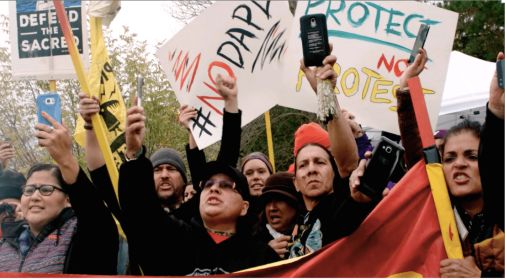Doc Corner: 'End of the Line: The Women of Standing Rock'
 Wednesday, July 7, 2021 at 1:30PM
Wednesday, July 7, 2021 at 1:30PM By Glenn Dunks

The politics of protest are always going to provide filmmakers with the sort of loaded emotions that make for good movies. Even when peaceful, the fractured dynamics of a society that continuously pits side against side in the fight for progressive ideas have long produced the sorts of anger and fierce determination that explode on camera. Racial equality (and more recently, Black Lives Matter), queer rights and women’s liberation have all been seen in compelling documentaries for decades.
But as environmental issues become more engrained as a fixture in the political and societal landscape, the street-battles to protect the only Earth we have are just as pertinent even if they perhaps lack the more personal connections that so many of us find in narratives of struggle and protest. In fact, Shannon Kring’s End of the Line: The Women of Standing Rock finds much of its power in the way race, gender and the environment overlap in the fight for our planet's future.
Its action is compelling as First Nations women take an important leadership role in the battle against the construction of an American conglomerate’s oil pipeline through sacred land (conveniently shifted south of Bismarck when it was decided that, yes, an oil spill would contaminate an even larger water supply for North Dakota). It’s drama, however, feels unique as Native American women are so rarely given a spotlight as they do in Kring’s second feature.
Of course, anybody paying attention to these sorts of environmental issues will be keenly aware that the story of the Dakota Access Pipeline is not strange or new. It’s little more than a transparent ecological assault, built around insidious corporate greed. As a story of protest, too, it is nothing new. The film observes as the peaceful protest begins, First Nations people erecting tents in their Sacred Stone Camp on the reservation land that was marked for their use, but which has been stripped for access by capitalism incarnate. We watch as more and more arrive to lend their voice through both protest and song (including Australian Aboriginal representatives, and Norwegian Sami people). But as more tractors arrive, more barbed wire appears, more uniformed and militarized guards take their position with guns and batons, End of the Line defies the viewer to suggest that this is anything by a gross overstep of authority on behalf of everybody with power. And it’s clear that the tribes are not the ones with the power.

Filmed predominantly in 2016 before the inauguration of Donald Trump, End of the Line is perhaps most notable for featuring previously unseen footage of the police brutality that was inflicted upon those who were attacked for taking their rightful place on their ancestor’s land. The enforcement video shows the violent attempts made against the peaceful protestors, including rubber bullets (which blinded one) and drag-out assaults. It’s unflinching, uncomfortable stuff, but one that is far too familiar.
However, it is the focus on the women of these tribes that allows Kring to delve into other, thornier subject matter. From the very nature of womanhood within the First Nations population, to the issue of forces sterilization and systemic abuse of white houses of religion, this documentary grapples with subject matters that positions the fight for Standing Rock not as just one based around environmental stakes for one lake on the Missouri River, but that of the very rights to for Native Americans—and all First Nations people—to exist as they see fit to among western culture. By allowing these people on the ground to speak at the heart of the film is significant. It does so simply and effectively with little need for sensationalizing. By doing so it makes as almost a strong of a case for their cause than the women do themselves. Like Marion Lipschutz’s Young Lakota, I so embraced being welcomed into this world and the work of its people like Wašté Win Young, Phyllis Young, Vanessa “Sioux-Z” Dundon and many others. I hope films like End of the Line don’t remain as rare as they once have as the world finally opens up to hearing their stories.
Release: End of the Line: The Women of Standing Rock is available through Fuse.
Oscar chances: Hmm, probably not. The film has unfortunately not made a very loud splash on the festival circuit since its premiere at Slamdance, and that's something that most docs have if not impressive box office.
 Doc Corner,
Doc Corner,  First Nations,
First Nations,  Review,
Review,  documentaries
documentaries 

